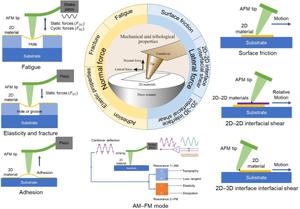Friction ( IF 6.3 ) Pub Date : 2024-07-10 , DOI: 10.1007/s40544-024-0864-9 Shuai Wu , Jie Gu , Ruiteng Li , Yuening Tang , Lingxiao Gao , Cuihua An , Qibo Deng , Libin Zhao , Ning Hu

|
Two-dimensional (2D) materials are potential candidates for electronic devices due to their unique structures and exceptional physical properties, making them a focal point in nanotechnology research. Accurate assessment of the mechanical and tribological properties of 2D materials is imperative to fully exploit their potential across diverse applications. However, their nanoscale thickness and planar nature pose significant challenges in testing and characterizing their mechanical properties. Among the in situ characterization techniques, atomic force microscopy (AFM) has gained widespread applications in exploring the mechanical behaviour of nanomaterials, because of the easy measurement capability of nano force and displacement from the AFM tips. Specifically, AFM-based force spectroscopy is a common approach for studying the mechanical and tribological properties of 2D materials. This review comprehensively details the methods based on normal force spectroscopy, which are utilized to test and characterize the elastic and fracture properties, adhesion, and fatigue of 2D materials. Additionally, the methods using lateral force spectroscopy can characterize the interfacial properties of 2D materials, including surface friction of 2D materials, shear behaviour of interlayers as well as nanoflake-substrate interfaces. The influence of various factors, such as testing methods, external environments, and the properties of test samples, on the measured mechanical properties is also addressed. In the end, the current challenges and issues in AFM-based measurements of mechanical and tribological properties of 2D materials are discussed, which identifies the trend in the combination of multiple methods concerning the future development of the in situ testing techniques.
中文翻译:

AFM力谱在二维材料机械和摩擦学表征方面的进展
二维(2D)材料因其独特的结构和卓越的物理性能而成为电子设备的潜在候选者,使其成为纳米技术研究的焦点。为了充分发挥二维材料在不同应用中的潜力,必须准确评估二维材料的机械和摩擦学性能。然而,它们的纳米级厚度和平面性质对测试和表征其机械性能提出了重大挑战。在原位表征技术中,原子力显微镜(AFM)由于能够轻松测量AFM尖端的纳米力和位移,因此在探索纳米材料的机械行为方面获得了广泛的应用。具体来说,基于 AFM 的力谱是研究二维材料机械和摩擦学性能的常用方法。这篇综述全面详细介绍了基于法向力谱的方法,这些方法用于测试和表征二维材料的弹性和断裂性能、粘合性和疲劳性能。此外,使用横向力谱的方法可以表征二维材料的界面特性,包括二维材料的表面摩擦、夹层的剪切行为以及纳米片-基底界面。还讨论了测试方法、外部环境和测试样品的性能等各种因素对测量的机械性能的影响。最后,讨论了基于 AFM 的二维材料机械和摩擦学性能测量中当前的挑战和问题,确定了原位测试技术未来发展的多种方法相结合的趋势。






























 京公网安备 11010802027423号
京公网安备 11010802027423号